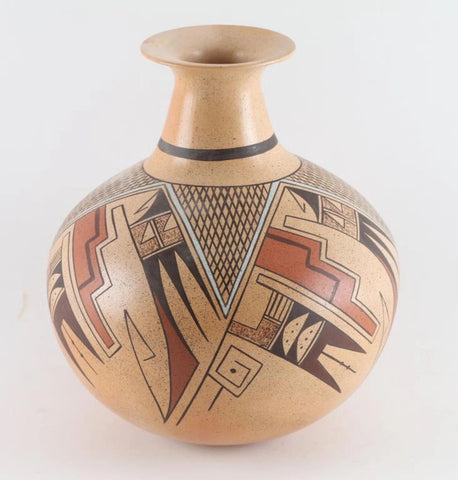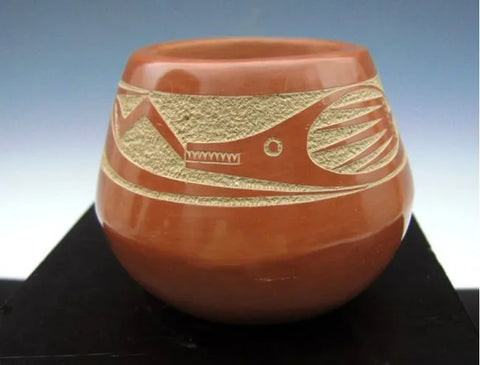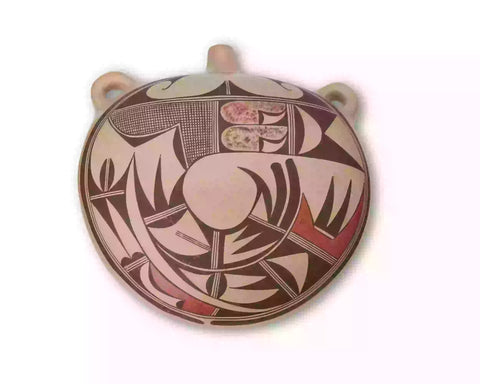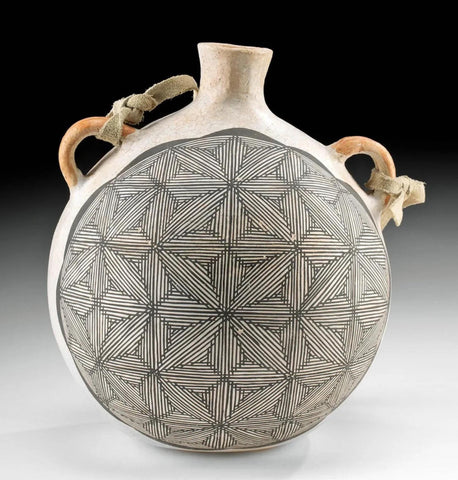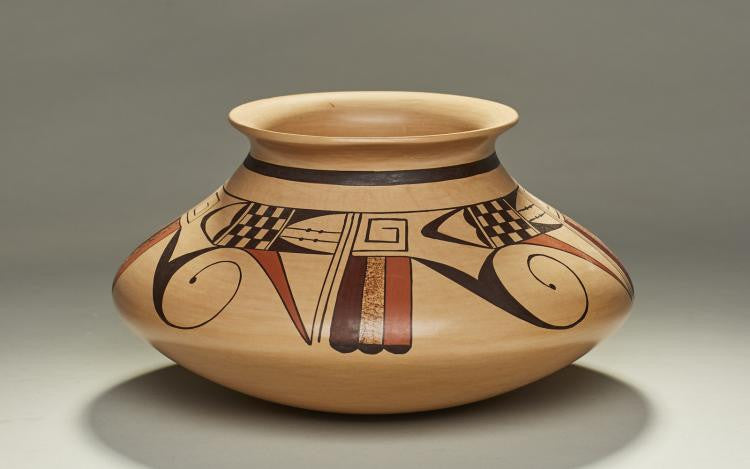
Native American Indian Hopi Pottery, by Dee Setalla #1758
$ 1,500.00
Native American
Indian Hopi Pottery Jar signed Dee Setalla.
#1758 Description: Native American Indian Hopi Pottery Jar signed Dee Setalla. The decorated bowl is signed Dee Setalla Hopi, K.C. Az.
Native American
Indian Hopi Pottery Jar signed Dee Setalla.
#1758 Description: Native American Indian Hopi Pottery Jar signed Dee Setalla. The decorated bowl is signed Dee Setalla Hopi, K.C. Az.
Condition: In good condition.
Dimensions: Measures 5 inches high by 9.5 inches diameter.
Some background data on the artist:
"Dee Johnson Setalla. is a member of the Hopi Tribe. he was born and raised in Snowbird Canyon, Arizona. Since he is part of the Bear Clan (Mother - Bear Clan) he signs his pottery with a Bear Claw.
Dee started making pottery around the age of 6 years old. Most of his teachings came from great potters such as his mother Pauline Setalla, and Aunt Eunice "Fawn" Navasie, who was a well known Hopi potter.
He does traditional designs such as birds, moths or butterflies, bear claws, clouds and rain (Father - Water Clan) designs. His pottery is known for its thin walls and high polish.
The gray clay that he molds his pottery with is dug up on the Hopi reservation. Once the clay is prepared it is hand coiled. Coiling is the ancient way that Hopi's still make pottery. Paint for the pottery comes from local plants which are picked by the handfuls in the spring then boiled in a large tub of water until they condense into a black substance. Pottery is painted with a paint brush which comes from a yucca stem. The ends are chewed and trimmed to various sizes. The designs are painted freehand. The pottery is eventually transferred outdoors to be fired with sheep dung.
his art is the contribution of a thousand years of Hopi art and cultural expression. When working with the clay, he says "it is like you're bringing it to life. You must treat it with respect. You treat it like you are raising a child, and guide it through the growing stages. It's not just steps out of tradition, but a personal nurturing as well. You must be very grateful for the clay and pottery. I pray each morning with cornmeal. When we dig clay, we leave food there. You can't be greedy and not leave anything".
Pottery in the younger Hopi generations is slowly fading out. Dee would like to devote his time to teaching this generation the art of pottery, and what it means to me. Being a mentor would play an important role for him.
Dee has shown and won ribbons at various venues including: August 1997 - Santa Fe Indian Market: 1st Place -Traditional Hopi Pottery Jar;
February 1998 - Scottsdale Community College Rez Art Show: Merit Award - Seed Pot; Museum of Northern Arizona Hopi Show: 3rd Place - Large Hopi Jar, Honorable Mention - Medium Seed Pot." (Source: Ancient Nations).
A History of Pueblo Pottery:
“Pueblo pottery is made using a coiled technique that came into northern Arizona and New Mexico from the south, some 1500 years ago. In the four-corners region of the US, nineteen pueblos and villages have historically produced pottery. Although each of these pueblos use similar traditional methods of coiling, shaping, finishing and firing, the pottery from each is distinctive.
Various clay's gathered from each pueblo’s local sources produce pottery colors that range from buff to earthy yellows, oranges, and reds, as well as black. Fired pots are sometimes left plain and other times decorated—most frequently with paint and occasionally with appliqué. Painted designs vary from pueblo to pueblo, yet share an ancient iconography based on abstract representations of clouds, rain, feathers, birds, plants, animals and other natural world features.
Tempering materials and paints, also from natural sources, contribute further to the distinctiveness of each pueblo’s pottery. Some paints are derived from plants, others from minerals. Before firing, potters in some pueblos apply a light colored slip to their pottery, which creates a bright background for painted designs or simply a lighter color plain ware vessel. Designs are painted on before firing, traditionally with a brush fashioned from yucca fiber.
Different combinations of paint color, clay color, and slips are characteristic of different pueblos. Among them are black on cream, black on buff, black on red, dark brown and dark red on white (as found in Zuni pottery), matte red on red, and polychrome—a number of natural colors on one vessel (most typically associated with Hopi). Pueblo potters also produce undecorated polished black ware, black on black ware, and carved red and carved black wares.
Making pueblo pottery is a time-consuming effort that includes gathering and preparing the clay, building and shaping the coiled pot, gathering plants to make the colored dyes, constructing yucca brushes, and, often, making a clay slip. While some Pueblo artists fire in kilns, most still fire in the traditional way in an outside fire pit, covering their vessels with large potsherds and dried sheep dung. Pottery is left to bake for many hours, producing a high-fired result.
Today, Pueblo potters continue to honor this centuries-old tradition of hand-coiled pottery production, yet value the need for contemporary artistic expression as well. They continue to improve their style, methods and designs, often combining traditional and contemporary techniques to create striking new works of art.” (Source: Museum of Northern Arizona): In good condition.
Dimensions: Measures 5 inches high by 9.5 inches diameter.
Some background data on the artist:
"Dee Johnson Setalla. is a member of the Hopi Tribe. he was born and raised in Snowbird Canyon, Arizona. Since he is part of the Bear Clan (Mother - Bear Clan) he signs his pottery with a Bear Claw.
Dee started making pottery around the age of 6 years old. Most of his teachings came from great potters such as his mother Pauline Setalla, and Aunt Eunice "Fawn" Navasie, who was a well known Hopi potter.
He does traditional designs such as birds, moths or butterflies, bear claws, clouds and rain (Father - Water Clan) designs. His pottery is known for its thin walls and high polish.
The gray clay that he molds his pottery with is dug up on the Hopi reservation. Once the clay is prepared it is hand coiled. Coiling is the ancient way that Hopi's still make pottery. Paint for the pottery comes from local plants which are picked by the handfuls in the spring then boiled in a large tub of water until they condense into a black substance. Pottery is painted with a paint brush which comes from a yucca stem. The ends are chewed and trimmed to various sizes. The designs are painted freehand. The pottery is eventually transferred outdoors to be fired with sheep dung.
his art is the contribution of a thousand years of Hopi art and cultural expression. When working with the clay, he says "it is like you're bringing it to life. You must treat it with respect. You treat it like you are raising a child, and guide it through the growing stages. It's not just steps out of tradition, but a personal nurturing as well. You must be very grateful for the clay and pottery. I pray each morning with cornmeal. When we dig clay, we leave food there. You can't be greedy and not leave anything".
Pottery in the younger Hopi generations is slowly fading out. Dee would like to devote his time to teaching this generation the art of pottery, and what it means to me. Being a mentor would play an important role for him.
Dee has shown and won ribbons at various venues including: August 1997 - Santa Fe Indian Market: 1st Place -Traditional Hopi Pottery Jar;
February 1998 - Scottsdale Community College Rez Art Show: Merit Award - Seed Pot; Museum of Northern Arizona Hopi Show: 3rd Place - Large Hopi Jar, Honorable Mention - Medium Seed Pot." (Source: Ancient Nations).
A History of Pueblo Pottery:
“Pueblo pottery is made using a coiled technique that came into northern Arizona and New Mexico from the south, some 1500 years ago. In the four-corners region of the US, nineteen pueblos and villages have historically produced pottery. Although each of these pueblos use similar traditional methods of coiling, shaping, finishing and firing, the pottery from each is distinctive.
Various clay's gathered from each pueblo’s local sources produce pottery colors that range from buff to earthy yellows, oranges, and reds, as well as black. Fired pots are sometimes left plain and other times decorated—most frequently with paint and occasionally with appliqué. Painted designs vary from pueblo to pueblo, yet share an ancient iconography based on abstract representations of clouds, rain, feathers, birds, plants, animals and other natural world features.
Tempering materials and paints, also from natural sources, contribute further to the distinctiveness of each pueblo’s pottery. Some paints are derived from plants, others from minerals. Before firing, potters in some pueblos apply a light colored slip to their pottery, which creates a bright background for painted designs or simply a lighter color plain ware vessel. Designs are painted on before firing, traditionally with a brush fashioned from yucca fiber.
Different combinations of paint color, clay color, and slips are characteristic of different pueblos. Among them are black on cream, black on buff, black on red, dark brown and dark red on white (as found in Zuni pottery), matte red on red, and polychrome—a number of natural colors on one vessel (most typically associated with Hopi). Pueblo potters also produce undecorated polished black ware, black on black ware, and carved red and carved black wares.
Making pueblo pottery is a time-consuming effort that includes gathering and preparing the clay, building and shaping the coiled pot, gathering plants to make the colored dyes, constructing yucca brushes, and, often, making a clay slip. While some Pueblo artists fire in kilns, most still fire in the traditional way in an outside fire pit, covering their vessels with large potsherds and dried sheep dung. Pottery is left to bake for many hours, producing a high-fired result.
Today, Pueblo potters continue to honor this centuries-old tradition of hand-coiled pottery production, yet value the need for contemporary artistic expression as well. They continue to improve their style, methods and designs, often combining traditional and contemporary techniques to create striking new works of art.” (Source: Museum of Northern Arizona)





